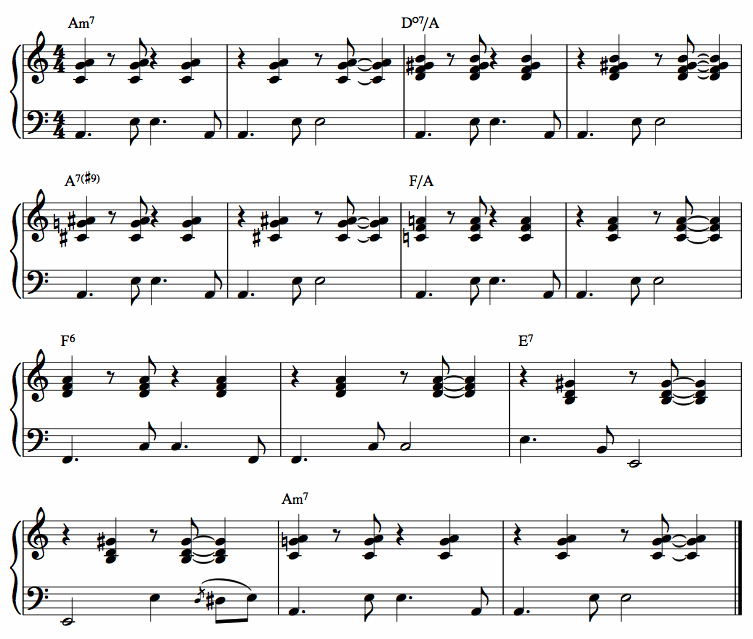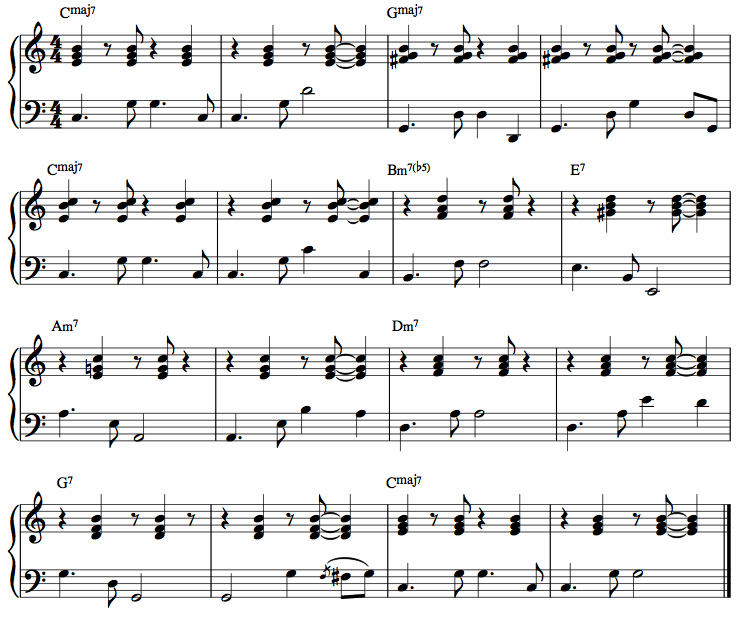Piano Lesson: Introduction to Bossa Nova for Piano
by Christian Morris
Assumed knowledge:
The first stage is to master a Bossa Nova rhythm. These are hugely varied, but a basic version can be said to consist of a steady on-the-beat pattern in the left hand with a right hand that is more syncopated.
Here is the right hand:
Here is the left:
Both together:
Itís worth practising this tricky rhythm by tapping it out away from the piano. Tap out each hand individually and then together. Then try it on the piano. Itís a good idea to practise with a metronome. Slowly at first!
Now we add chords to this rhythm. The seventh chord gives us the right harmonic flavour.
The trickiest part of Bossa Nova is in developing some independence between the left and right hands. Here the left hand, as is common in the style, emphasises the root and fifth note of the chord being played in the right hand.
This version gives a little more independence to the left hand. Practise slowly to begin; it is very tricky!
Of course, you canít stay on the same chord forever! So here is a little progression based upon our Bossa Nova riff pattern. To keep things simple weíll use the easier version of the left hand.
There are many other good chord progressions to use with this style. Here is one, again with a simple bass line:
And here is one in a major key. The left hand has much more freedom:
 Now try our Bossanova Playalong Track
Now try our Bossanova Playalong Track
- Intermediate piano ability.
The first stage is to master a Bossa Nova rhythm. These are hugely varied, but a basic version can be said to consist of a steady on-the-beat pattern in the left hand with a right hand that is more syncopated.
Here is the right hand:
Here is the left:
Both together:
Itís worth practising this tricky rhythm by tapping it out away from the piano. Tap out each hand individually and then together. Then try it on the piano. Itís a good idea to practise with a metronome. Slowly at first!
Now we add chords to this rhythm. The seventh chord gives us the right harmonic flavour.
The trickiest part of Bossa Nova is in developing some independence between the left and right hands. Here the left hand, as is common in the style, emphasises the root and fifth note of the chord being played in the right hand.
This version gives a little more independence to the left hand. Practise slowly to begin; it is very tricky!
Of course, you canít stay on the same chord forever! So here is a little progression based upon our Bossa Nova riff pattern. To keep things simple weíll use the easier version of the left hand.
There are many other good chord progressions to use with this style. Here is one, again with a simple bass line:
And here is one in a major key. The left hand has much more freedom:









